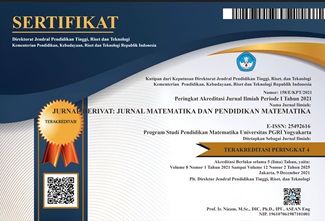Kemampuan Computational Thinking Materi Fungsi Eksponensial Menggunakan Problem Based Learning
DOI:
https://doi.org/10.31316/jderivat.v11i1.6129Abstract
The development of technology in the 21st era is growing very rapidly, especially in the field of education. Learners are required to be able to hone skills, one of which is Computational Thinking (CT). This study aims to describe the emergence of indicators of students' CT ability through problem-based learning on exponential functions. This research is a descriptive qualitative research with the research subject, namely class X students of SMA Negeri 10 Palembang as many as 50 students with the focus of the subject, namely 3 students who have high, medium, and low abilities.. This research was conducted through preparation, implementation, and data analysis stages. The data in this study were collected through written tests and interviews with the aim of measuring students' CT abilities. The results obtained will be analyzed through three stages, namely data reduction, data presentation, and conclusion drawing. The results showed that the indicators of students' CT abilities on exponential function material were well seen, namely decomposition, pattern recognition, and abstraction. As for algorithm indicators, students are still not precise in solving problems systematically with the right answers.
The development of technology in the 21st era is growing very rapidly, especially in the field of education. Learners are required to be able to hone skills, one of which is Computational Thinking (CT). This study aims to describe the emergence of indicators of students' CT ability through problem-based learning on exponential functions. This research is a descriptive qualitative research with the research subject, namely class X students of SMA Negeri 10 Palembang as many as 50 students with the focus of the subject, namely 3 students who have high, medium, and low abilities.. This research was conducted through preparation, implementation, and data analysis stages. The data in this study were collected through written tests and interviews with the aim of measuring students' CT abilities. The results obtained will be analyzed through three stages, namely data reduction, data presentation, and conclusion drawing. The results showed that the indicators of students' CT abilities on exponential function material were well seen, namely decomposition, pattern recognition, and abstraction. As for algorithm indicators, students are still not precise in solving problems systematically with the right answers.
Keywords: Computational Thinking Ability, Exponential Function, Problem Based Learning.
References
Agus, T. I., & Oktavianingtyas. (2016). Profil Pemecahan Masalah Kreatif Siswa Bergaya Belajar Visual Berdasarkan Gender Pada Materi Segitiga dan Segiempat di Kelas VII SMP Negeri 4 Jember. Artikel Ilmah Mahasiswa, 3(2), 1–6.
Azmi, R. D., & Ummah, S. K. (2021). Analisis Kemampuan Computational Thinking Dalam Pembuatan Media Pembelajaran Matematika. Jurnal Pendidikan Matematika (JUDIKA EDUCATION), 4(1), 34–40. https://doi.org/10.31539/judika.v4i1.2273
Junengsih, J., & Sutirna, S. (2022). Analisis Kesulitan Siswa dalam Mengerjakan Soal pada materi Eksponen. Jurnal Ilmiah Dikdaya, 12(1), 28–32. https://doi.org/http://dx.doi.org/10.33087/dikdaya.v12i1.303
Lestari, M. (2019). Implementasi Model Pembelajaran Berbasis Intuisi Terhadap Kreatifitas Siswa. JURNAL PENDIDIKAN MATEMATIKA (KUDUS), 2(1). https://doi.org/10.21043/jpm.v2i1.6339
Pebriana, R., & Disman, D. (2017). Effect of Problem Based Learning to Critical Thinking Skills Elementary School Students in Social Studies. Journal of Elementary Educationducation, 1(1), 109–118. https://doi.org/https://doi.org/10.22460/pej.v1i1.487
PISA. (2018). PISA 2018 Result (Volume I).
Pratiwi, L. G., Akbar, B., & Hamka, M. (2018). Pengaruh Model Problem Based Learning Terhadap Keterampilan Computational Thinking Matematis Siswa Kelas IV SDN Kebon Bawang 03 Jakarta. Jurnal Eksakta Pendidikan (JEP), 2(2), 170–177. https://doi.org/https://doi.org/10.36989/didaktik.v8i1.302
Rahma, A. F., & Khabibah, S. (2022). Analisis Kesalahan Siswa SMA dalam Menyelesaikan Soal Eksponen. MATHEDdunesa Jurnal Ilmiah Pendidikan Matematika, 11(2). https://doi.org/https://doi.org/10.26740/mathedunesa.v11n2.p446-457
Satrio, W. A. (2020). Pengaruh Model Pembelajaran KADIR (Koneksi,Aplikasi,Diskursus,Impprovisasi,Dan Refleksi) Terhadap Kemampuan Berpikir Komputasional Matematis Siswa. Universitas Islam Negeri Syarif Hidayatullah.
Sidik, G. T., Rohaeti, E. E., Murni, S., & Puspita, R. D. (2023). Kajian Implementasi Problem Based Learning dalam Meningkatkan Hasil Belajar Ilmu Pengetahuan Sosial Siswa Sekolah Dasar. Collase: Creative of Learning Students Elementary Education., 6(1), 196–201.
Silvia, P., & Mulyaniapi, T. (2022). Analisis Kemampuan Computational Thinking Melalui Pembelajaran Coding Pada Anak Usia Dini 0-8 Tahun. Journal of Islamic Early Childhood Education (JOIECE): PIAUD-Ku, 1(2), 50–59. https://doi.org/10.54801/piaudku.v1i2.140
Supiarmo, G. M., Mardhiyatirrahmah, L., & Turmudi, T. (2021). Pemberian Scaffolding untuk Memperbaiki Proses Berpikir Komputasional Siswa dalam Memecahkan Masalah Matematika. Jurnal Cendekia, 5(1), 368–382. https://doi.org/https://doi.org/10.31004/cendekia.v5i1.516
Susanti, E., Zulkardi, Z., & Yusuf Hartono. (2018). Desain Pembelajaran Materi Eksponen dengan Konteks Perkembangan Tubuh Manusia. Cakrawala Pendidikan, 1, 97–106. https://doi.org/https://doi.org/10.21831/cp.v37i1.17800
Topa, S. Il, Setiawani, S., & Oktavianingtyas, E. (2018). Analisis Kesalahan Siswa Kelas X Dalam Menyelesaikan Permasalahan Fungsi Eksponen Ditinjau Dari Gender. Kadikma, 9(3), 42–50. https://doi.org/https://doi.org/10.19184/kdma.v9i3.10760
Vhalery, R., Setyastanto, A. M., & Leksono, A. W. (2022). Kurikulum Merdeka Belajar Kampus Merdeka: Sebuah Kajian Literatur. Research and Development Journal of Education, 8(1), 185. https://doi.org/10.30998/rdje.v8i1.11718
Wati, M., Larasati, V., Suyidno, S., & Sasmita, F. D. (2022). Pengembangan Materi Ajar Bermuatan Authentic Learning Untuk Meningkatkan Keterampilan Pemecahan Masalah Peserta Didik. Jurnal Pendidikan Fisika, 10(2), 229. https://doi.org/10.24127/jpf.v10i2.5782
Downloads
Published
Issue
Section
Citation Check
License
Copyright (c) 2024 Nabilah Hauda, Budi Mulyono, Hapizah

This work is licensed under a Creative Commons Attribution-ShareAlike 4.0 International License.
Authors who publish with this journal agree to the following terms:
-
Authors retain copyright and grant the journal right of first publication with the work simultaneously licensed under a Creative Commons Attribution-ShareAlike 4.0 International License that allows others to share the work with an acknowledgment of the work's authorship and initial publication in this journal.
- Authors are able to enter into separate, additional contractual arrangements for the non-exclusive distribution of the journal's published version of the work (e.g., post it to an institutional repository or publish it in a book), with an acknowledgment of its initial publication in this journal.
- Authors are permitted and encouraged to post their work online (e.g., in institutional repositories or on their website) prior to and during the submission process, as it can lead to productive exchanges, as well as earlier and greater citation of published work (See The Effect of Open Access).







